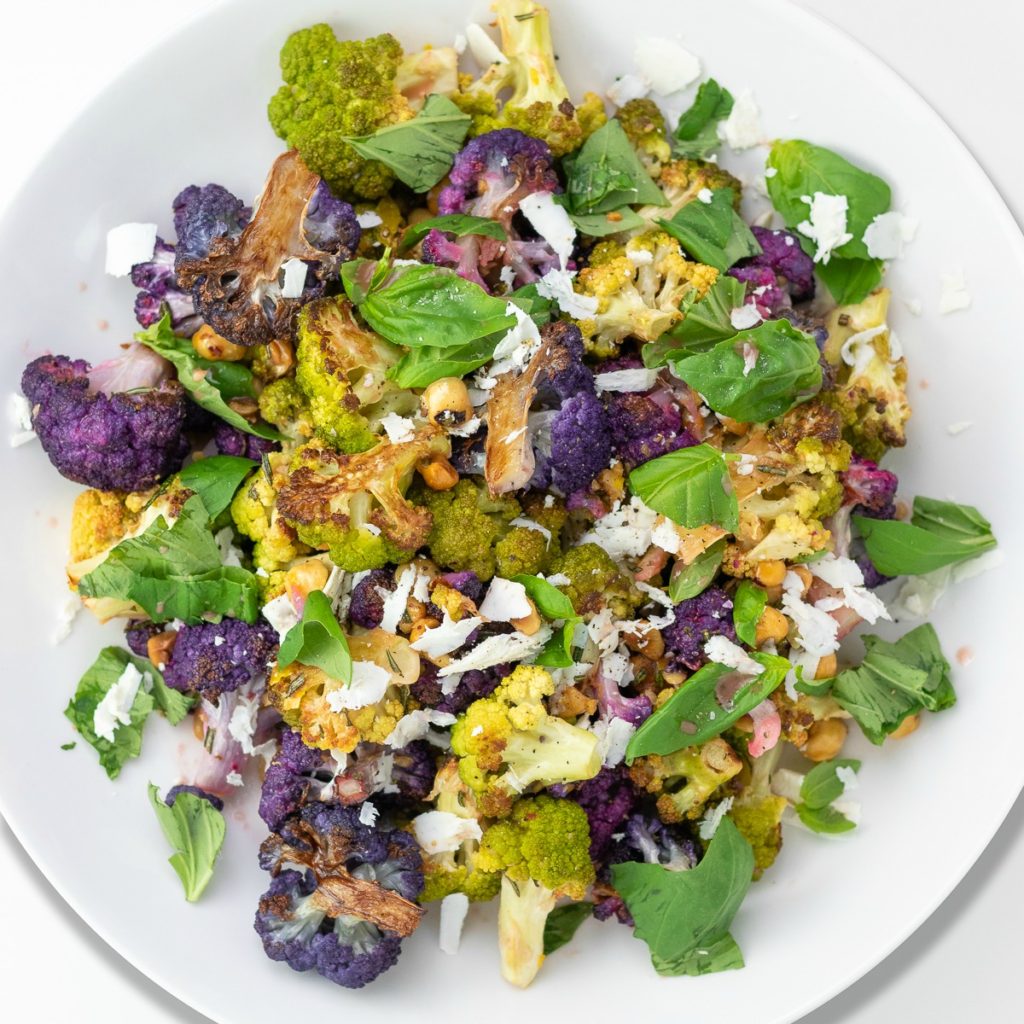
Roasted Rainbow Cauliflower with Ricotta Salata & Hazelnuts
The new hues of cauliflower—purple, orange, and green—that emerge in late summer and early fall completely revive my desire to cook with and consume this vegetable. Hence, they’re the basis for this recipe (but the standard white variety works just as well). The key to any great-tasting cauliflower is to good caramelization (olive oil, salt, and a screamin’ hot pan). Then douse them in this recipe’s nutty, umami-laced vinaigrette and your love of cauliflower will be renewed no matter the season or reason.

An easy and delicious vegetable side dish that's everyday or holiday perfect.
- 2 medium heads purple, green, orange, or white cauliflower, leaves and stem removed and cut into medium florets
- 6 tbsp. olive oil, divided
- 1 tsp. kosher salt
- 1 tbsp. anchovy paste (from tube, see TIP A below)
- zest and juice of 1 lemon
- 1 tbsp. white balsamic vinegar
- 1/2 tsp. granulated garlic (coarse garlic powder)
- 2 tsp. pure maple syrup
- 1/3 c. (heaping) roasted hazelnuts (skin removed, see TIP B below), coarsely chopped
- 1 tbsp. fresh rosemary leaves, coarsely chopped
- 1-2 oz. ricotta salata cheese, shaved or crumbled
- 1/3 c. torn basil leaves
- additional kosher or flake sea salt, for finishing
-
Set your oven to 450° and put an empty large, rimmed baking sheet on the center rack so that it comes up to temperature with the oven. You want it good and hot so that it creates a sear on the bottom of the cauliflower almost instantly (a great oven-roasting technique for just about any veg). Meanwhile put the cauliflower florets in a large bowl and douse them with 4 tablespoons olive oil (reserve remaining oil) and 1 teaspoon kosher salt. Gently toss to coat. Once the oven has reached 450°, pull the hot baking sheet from the oven (using an oven mitt), quickly spread the seasoned florets in an even layer across the baking sheet, and return the sheet pan to the oven for the cauliflower to roast for 22-26 minutes.
-
Meanwhile, combine the anchovy paste, lemon zest and juice, white balsamic vinegar, and granulated garlic in a large bowl (use the same bowl that you used to season the cauliflower). Whisk these ingredients together until fully incorporated. Then warm the remaining 2 tablespoons olive oil and 2 teaspoons maple syrup in a small skillet over medium-low heat. Add the chopped hazelnuts and rosemary and let sizzle (stirring occasionally) for 2-3 minutes or until the rosemary starts to brown and crisp around the edges. When ready, immediately transfer the sizzling rosemary-hazelnut mixture (including every last bit of the oil and maple syrup) to the bowl with the lemon juice mixture. Gently stir to combine. Set aside until ready to use.
-
When the cauliflower florets have turned golden brown on the bottom, pull them from the oven and use a metal spatula to loosen each piece from the pan. Transfer the florets to the bowl with the vinaigrette and gently stir to combine. Let these ingredients hang-out for a minute or two as you tear the basil and shave or crumble the ricotta salata cheese (easiest to do from a really cold wedge or hunk). Then spread the cauliflower-vinaigrette mixture across a low, flat platter or bowl. Evenly distribute the torn basil and ricotta salata over top and sprinkle everything with a few pinches of flake sea salt or kosher salt. Serve immediately.
TIP A: If a tube of anchovy paste is not yet a staple in your refrigerator door, then you're missing out on the chance to infuse your cooking with that indescribable, captivating flavor sense called by the name "umami." Despite being made of anchovies and often shelved in the grocery store near canned fish, I find that anchovy paste is not fishy at all (and that's coming from someone who wouldn't dream of eating a whole anchovy fillet or even a tuna fish sandwich). Trust me. If needed, tip-toe in by using just a teaspoon in your next salad dressing. You'll be amazed. Then go for the full tablespoon required for this recipe. It's everything with the tangy lemon juice, nutty cauliflower, sweet hazelnuts, and earthy rosemary.
TIP B: If you're lucky enough to find skin-less, roasted hazelnuts in the store, then you can bypass this tip entirely (or maybe just read-on for curiosity sake). Most of the time, hazelnuts are sold whole and raw with the skin on. The skin is not bad for you or bad-tasting, it's just not the most pleasant texture in your mouth when it invariably flakes away from the meat of the nut. Removing the skin from whole hazelnuts is actually quite easy. Just spread them across a small baking sheet and pop them in a pre-heated 350° for about 10-12 minutes until the skins blister. Then immediately wrap them in a clean dry towel, let the steam build for a minute or two, then rub or roll them within the towel until they are mostly free of skins (it's ok if some skin remains).
